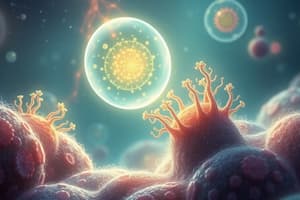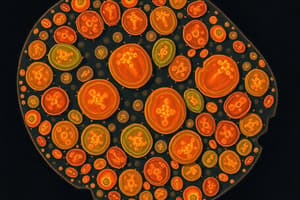Podcast
Questions and Answers
Which characteristic is unique to eukaryotes and not found in bacteria or archaea?
Which characteristic is unique to eukaryotes and not found in bacteria or archaea?
- Asexual reproduction
- Sexual reproduction
- Cells with membrane-bound organelles (correct)
- Heterotrophic nutrition
Why is the classification of protists particularly challenging, leading to the abandonment of Protista as a kingdom?
Why is the classification of protists particularly challenging, leading to the abandonment of Protista as a kingdom?
- Protists reproduce only sexually.
- Protists constitute a paraphyletic group. (correct)
- Protists lack membrane-bound organelles.
- Protists exhibit exclusively multicellular organization.
How does the nutritional diversity of eukaryotes compare to that of bacteria and archaea?
How does the nutritional diversity of eukaryotes compare to that of bacteria and archaea?
- Eukaryotes are only heterotrophs; they must consume other organisms.
- Eukaryotes exhibit more nutritional diversity, including photoautotrophs, heterotrophs, and mixotrophs. (correct)
- Eukaryotes are exclusively photoautotrophs.
- Eukaryotes exhibit less nutritional diversity.
What is the significance of endosymbiosis in the evolution of eukaryotes?
What is the significance of endosymbiosis in the evolution of eukaryotes?
What defines secondary endosymbiosis, as seen in the evolution of certain algae?
What defines secondary endosymbiosis, as seen in the evolution of certain algae?
Which characteristic is used to classify the Excavata supergroup?
Which characteristic is used to classify the Excavata supergroup?
What is the role of the kinetoplast in kinetoplastids?
What is the role of the kinetoplast in kinetoplastids?
What evolutionary event is associated with the origin of the Chromalveolata clade?
What evolutionary event is associated with the origin of the Chromalveolata clade?
What are alveoli, and in which protist group are they found?
What are alveoli, and in which protist group are they found?
What adaptation do apicomplexans possess for their parasitic lifestyle?
What adaptation do apicomplexans possess for their parasitic lifestyle?
How does alternation of generations manifest in multicellular algae?
How does alternation of generations manifest in multicellular algae?
What is the function of pseudopodia in rhizarians?
What is the function of pseudopodia in rhizarians?
What is the distinguishing characteristic of red algae that gives them their color?
What is the distinguishing characteristic of red algae that gives them their color?
Which group of green algae is most closely related to land plants?
Which group of green algae is most closely related to land plants?
Which eukaryotic supergroup contains both animals and fungi?
Which eukaryotic supergroup contains both animals and fungi?
Flashcards
Eukaryotes
Eukaryotes
Domain containing single and multi-celled organisms with membrane-bound organelles and cytoskeletons.
Protists
Protists
Informal name for the 'kingdom' of mostly unicellular eukaryotes; a paraphyletic group.
Photoautotrophs
Photoautotrophs
Eukaryotes that contain chloroplasts and produce their own food.
Heterotrophs
Heterotrophs
Signup and view all the flashcards
Mixotrophs
Mixotrophs
Signup and view all the flashcards
Mitochondria Endosymbiosis
Mitochondria Endosymbiosis
Signup and view all the flashcards
Plastids Endosymbiosis
Plastids Endosymbiosis
Signup and view all the flashcards
Secondary Endosymbiosis
Secondary Endosymbiosis
Signup and view all the flashcards
Six Supergroups of Eukarya
Six Supergroups of Eukarya
Signup and view all the flashcards
Excavata
Excavata
Signup and view all the flashcards
Diplomonads
Diplomonads
Signup and view all the flashcards
Parabasalids
Parabasalids
Signup and view all the flashcards
Chromalveolata
Chromalveolata
Signup and view all the flashcards
Alveolata
Alveolata
Signup and view all the flashcards
Archaeplastida
Archaeplastida
Signup and view all the flashcards
Study Notes
- Eukaryotes are defined as a domain containing single and multi-celled organisms.
- Eukaryotes have cells containing membrane-bound organelles
- Eukaryotic cells have cytoskeletons
- Eukaryotes get energy and nutrients in various ways
- Eukaryotes have a complex phylogeny.
Protists
-
The informal name of the "kingdom" of mostly unicellular eukaryotes is Protista
-
Advances in eukaryotic systematics have caused significant changes to protist classification
-
Protists are a paraphyletic group, and Protista is no longer a valid kingdom.
-
Protists are eukaryotes, so they have organelles and are more complex than bacteria and archaea
-
All eukaryotes that are not animals, plants, or fungi are protists
-
Most protists are unicellular, but some colonial and multicellular species exist
-
There are multiple versions of eukayotic trees
-
Plenty of disputes remain and the topic is complicated.
Basic Eukaryotic Biology
- Eukaryotes exhibit more structural and functional diversity than any other domain
- Single-celled eukaryotes can be very complex, with all biological functions carried out by organelles in each individual cell
- Eukaryotes are nutritionally diverse
- Some are Photoautotrophs: contain chloroplasts
- Some are Heterotrophs: which absorb organic molecules or ingest larger food particles
- Some are Mixotrophs: combine photosynthesis and heterotrophic nutrition
- Eukaryotes can reproduce asexually or sexually
- Various processes happen in each form of reproduction
- Mitosis in single-celled eukaryotes differs from the process in multicellular eukaryotes
- Meiosis is unique to eukaryotes.
- Much Eukaryote diversity is believed to have come from endosymbiosis
- Mitochondria evolved by endosymbiosis of an aerobic bacterium
- Plastids evolved by endosymbiosis of a photosynthetic cyanobacterium
- The plastid-bearing lineage of eukaryotes evolved into red and green algae
- On several occasions during eukaryotic evolution, red and green algae underwent secondary endosymbiosis and were ingested by a heterotrophic eukaryote
- It is not thought that amitochondriates (lacking mitochondria) are the oldest lineage of eukaryotes
- The understanding of the relationships among eukaryotic groups continues to change rapidly
- One division divides all eukaryotes into six supergroups.
Six Supergroups of Eukarya
- There are six supergroups: Excavata, Chromalveolata, Rhizaria, Archaeplastida, Amoebozoa, Opisthokonta
Excavata
- The clade Excavata is characterized by its cytoskeleton
- The controversial group includes the diplomonads, parabasalids, and euglenozoans
- Diplomonads have modified mitochondria called mitosomes
- They are often parasites such as Giardia intestinalis
- Parabasalids have reduced mitochondria called hydrogenosomes
- It includes Trichomonas vaginalis, the pathogen causing yeast infections in human females
- Euglenozoa is a diverse clade that all have a spiral or crystalline rod of unknown function inside their flagella
- Some are obligate photoautotrophs but the majority are heterotrophs
- Kinetoplastids have a single mitochondrion with an organized mass of DNA called a kinetoplast
- Many are parasitic such as Trypanosomes that causes African sleeping sickness, Chagas disease, and Leishmaniasis
- Euglenids have one or two flagella that emerge from a pocket at one end of the cell.
Chromalveolata
- This clade is monophyletic and originated by a secondary endosymbiosis event, including red algae.
- This clade is controversial and includes the alveolates and the stramenopiles
- Superphylum Alveolata protists have membrane-bounded sacs (alveoli) just under the plasma membrane
- Alveolata includes the dinoflagellates, apicomplexans, and ciliates
- Phylum Dinoflagellates are a diverse group of aquatic mixotrophs and heterotrophs
- These dinoflagellates are abundant components of both marine and freshwater phytoplankton
- Each dinoflagellate has a characteristic shape reinforced by internal plates of cellulose in many species
- Dinoflagellate blooms are the cause of toxic "red tides'
- Not all red tides are red
- Not all red tides are harmful
- Phylum Apicomplexa are parasites of animals that cause serious human diseases
- One end, the apex, contains a complex of organelles specialized for penetrating a host
- Most have sexual and asexual stages that require two or more different host species for completion
- The apicomplexan Plasmodium is the parasite that causes malaria
- Plasmodium requires both mosquitoes and humans to complete its life cycle
- Approximately 2 million people die from malaria each year
- Sickle-cell anemia confers some protection
Phylum Stramenopila
- Diatoms are unicellular algae with a unique two-part, glass-like wall of hydrated silica
- Golden algae are unicellular (some colonial) and are named for their color, which results from their yellow and brown carotenoids
- Brown algae are the largest and most complex algae
- All are multicellular, with most being marine
- Brown algae include species commonly called "seaweeds"
- The algal body is plantlike but lacks true roots, stems, and leaves, and is called a thallus
- The rootlike holdfast anchors the stemlike stipe which in turn supports the leaflike blades
- A variety of life cycles has evolved among multicellular algae
- The most complex life cycles include an alternation of generations or the alternation of multicellular haploid and diploid forms
- Heteromorphic generations are structurally different, while isomorphic generations look similar.
Rhizaria
- DNA evidence supports Rhizaria as a monophyletic clade
- Amoebas move and feed by pseudopodia; some, but not all, belong to the clade Rhizaria
- Rhizarians include forams and radiolarians
- Both have hard shells called tests
- Pseudopodia extends through holes in the test.
Archaeplastids
- Archaeplastida is used by some scientists, and it includes red algae, green algae, and land plants
- Over a billion years ago, a heterotrophic eukaryote acquired a cyanobacterial endosymbiont
- The photosynthetic descendants of this ancient eukaryote evolved into red and green algae
- Land plants descended from green algae
- Red algae are reddish in color due to an accessory pigment phycobilin, which masks the green of chlorophyll
- Red algae are usually multicellular; the largest are seaweeds
- Green algae are named for their grass-green chloroplasts
- Plants descended from green algae
- The two main groups of green algae are chlorophytes and charophyceans
- Most chlorophytes live in fresh water, although many are marine
- Other chlorophytes live in damp soil as symbionts in lichens or in snow.
Unikonts
- Proposed supergroup of eukaryotes that includes animals, fungi, and closely related eukaryotes
- Amoebozoans are a supported clade that include ameobas and slime molds
- Unikonts contain amoebozoa and opisthokonta groups
- Opisthokonts are fungi and animals, discussed in detail later.
Studying That Suits You
Use AI to generate personalized quizzes and flashcards to suit your learning preferences.




